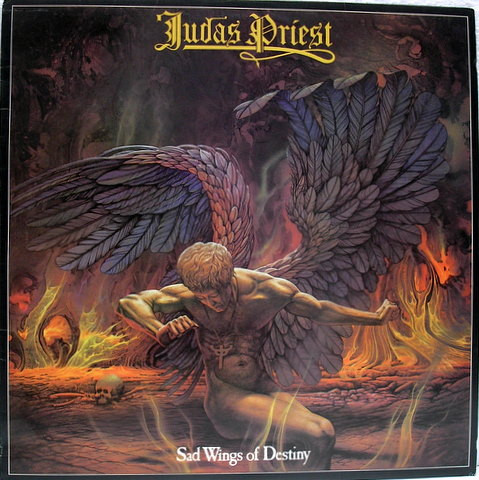„Island of Domination“ is the closing track of Judas Priest’s 1976 album Sad Wings of Destiny, an album that helped define the band’s early sound. Unlike some of the album’s more melancholic or introspective tracks, Island of Domination is a dark, aggressive, and theatrical piece that explores themes of tyranny, oppression, and submission to an all-powerful force.
Musically, it blends sinister, creeping passages with explosive, hard-hitting riffs, creating an ominous and foreboding atmosphere. The song’s cryptic and vivid lyrics leave room for multiple interpretations—ranging from a metaphor for totalitarian control to an allegory of personal struggle.
Overview
At its core, Island of Domination explores:
- A nightmarish, oppressive world where the protagonist is trapped under the rule of a powerful force.
- Themes of enslavement, suffering, and submission, presented in a highly theatrical, almost surreal manner.
- An allegory that could be interpreted politically, psychologically, or even spiritually.
- A musical blend of slow-burning dread and explosive release, mirroring the song’s themes of entrapment and resistance.
Narrative Structure & Themes
1. The Oppressive Setting & Imprisonment (Opening Verse & Introduction)
- The song begins with a sinister, crawling riff, setting the stage for a dark and oppressive world.
“Beware of their coming, take heed our time has come”
- A warning of impending doom—something powerful and terrifying is approaching.
- The sense of inevitability suggests that the protagonist (or society) is already doomed.
- Themes: Tyranny, submission, fear of the unknown.
2. The Torment of the Oppressed (Middle Verses & Imagery of Suffering)
- The lyrics quickly descend into graphic, brutal imagery:
“Marching in the streets / Dragging iron feet”
- The „iron feet“ suggest an unstoppable force, possibly a military or dictatorial rule.
- Themes: Oppression, authoritarianism, forced control.
“Chains of oppression / Dragging us down”
- The imagery of chains reinforces the theme of enslavement—the protagonist (or the people) are powerless.
- The „Island of Domination“ could symbolize a place where freedom is nonexistent, and escape is impossible.
- Themes: Slavery, suffering, inescapability.
3. Resistance or Forced Submission? (Climax & Emotional Height of the Song)
- As the song progresses, it questions whether there is a way out:
“Prison of love, shadow of life”
- These lines suggest a paradoxical relationship between the captors and the captives.
- The mention of „love“ in connection with imprisonment hints at forced devotion or submission—perhaps a metaphor for blind loyalty to a corrupt leader or system.
- Themes: Brainwashing, psychological control, the illusion of love.
- The climax erupts in chaotic, wailing vocals and aggressive instrumentation, suggesting a moment of panic, realization, or violent struggle.
4. The Finality of Enslavement (Closing Section & Descent into Doom)
- Unlike many classic rock or metal songs where there is a victorious escape or defiance, Island of Domination leaves the protagonist trapped:
“No use in escaping, you’re own your own”
- The finality of these words suggests that resistance is futile—the protagonist (or society) is completely at the mercy of their rulers.
- No heroism, no rebellion—only despair.
- Themes: Hopelessness, the crushing power of domination.
- The song ends with a sense of finality, making it a perfect closer to Sad Wings of Destiny, an album full of tragic, dramatic themes of suffering and lost hope.
Themes & Symbolism
1. Tyranny & Totalitarianism
- The „Island of Domination“ could represent a dystopian state, a dictatorship, or a brutal regime that strips people of their freedom.
- The song’s imagery of chains, marching soldiers, and oppression is reminiscent of historical authoritarian states.
2. Psychological Control & Submission
- The line “Prison of love, shadow of life” suggests that the victims might not even realize they are being controlled—they are trapped in a state of manipulated devotion.
- This could symbolize cult-like control, abusive relationships, or blind loyalty to an oppressive system.
3. The Inescapability of Fate
- The song’s structure and lyrics give no indication of escape or rebellion—instead, it emphasizes that once you fall under this power, there is no way out.
- This could reflect the despair of being caught in cycles of oppression, addiction, or inner torment.
Musical & Emotional Impact
1. The Sinister, Slow-Building Tension
- The slow, creeping intro creates an atmosphere of dread, as if something evil is approaching.
2. The Explosive Climax
- The song erupts into powerful, wailing vocals and heavy riffs, mirroring the chaos and panic of realizing one’s entrapment.
3. The Dramatic, Doomy Ending
- Unlike songs that offer redemption or catharsis, Island of Domination closes with a sense of inevitable doom, leaving the listener unsettled.
Legacy & Influence
- Island of Domination showcases Judas Priest’s early experimentation with dark, dystopian themes—something that would later be explored further in their more futuristic, sci-fi, and cyberpunk-influenced albums like Stained Class and Painkiller.
- The song’s imagery and storytelling align with later metal themes found in Iron Maiden, Dio, and even progressive metal bands like Queensrÿche.
- Its oppressive and nightmarish tone helped lay the foundation for darker forms of metal, influencing doom metal and power metal storytelling.
Final Verdict
„Island of Domination“ is a nightmarish, theatrical journey into a world of oppression, enslavement, and submission. Its cryptic lyrics paint an ominous picture of a powerful force crushing the will of its victims, whether interpreted politically, psychologically, or metaphorically.
Musically, it blends doom, heavy riffing, and Halford’s haunting vocal delivery to create an atmosphere of dread and finality. Unlike many metal songs that focus on rebellion and victory, this track offers no escape—only domination.
A dark, oppressive, and unforgettable closer, Island of Domination cements Judas Priest’s ability to blend heavy metal with deep, thought-provoking storytelling.



